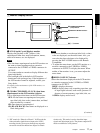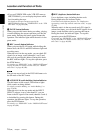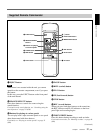
Chapter 1 Overview 19 (GB)
Chapter 1 Overview
(Continued)
2 INPUT connectors
Use to input analog video and audio signals. To
connect a device equipped with S-video output, use the
S VIDEO connector on the unit. During normal
recording, sounds are recorded onto channels 1 and 2;
they cannot be recorded onto channels 3 and 4. During
audio dubbing, sounds are dubbed onto channels 3 and
4.
Notes
• In the audio dubbing mode, the AUDIO (CH-1/3)
jack functions as channel 3 input and the AUDIO
(CH-2/4) jack functions as channel 4 input.
• To input balanced audio signals via AUDIO jacks,
use a conversion cable as shown below. (The COLD
side is open.)
For details on conversion cables, refer to the instruction
manual of the devices you use.
COLD ×
HOT
GND
3 AUDIO INPUT LEVEL (–10/–2/+4) selector
Selects one from among –10 dB, –2 dB, or +4 dB
according to the audio level of the signal input via the
AUDIO jacks in INPUT.
Notes
• If this selector setting is not appropriate, clipping
distortion or noise may occur.
• For more information on the setting of this selector,
see “When you set the AUDIO INPUT LEVEL
selector” on page 71 (GB).
4 NTSC/PAL select switch
Used to switch the color system of signals that will be
recorded on the unit when you use analog input.
Before inputting NTSC or PAL formatted analog video
signals, set this switch to the appropriate position
according to the color system of the signal input.
Notes
• If the color system of the input signals is different
from that of the switch setting, picture will be
blanked.
•While signals are input to the DV jack or during
playback, this switch setting is invalid. The unit
detects the color system of the signals automatically.
•When this switch is set to PAL, the unit works as a
PAL model. Therefore, the time code generated by
the unit during recording in the DVCAM format is
that of the non-drop frame mode. Even if an NTSC
formatted signal is input to the DV jack, the time
code generated by the unit is non-drop frame mode as
long as the switch is set to PAL, regardless of the TC
FORMAT setting on the TC/UB SET menu. If you
intend to set the unit to generate the time code in the
drop frame mode, set this switch to NTSC.
• The color system of the signals output from the unit
is the one recorded on the tape being played back.
The unit cannot convert the color system of signals of
one system into that of the other. (For example:
converting NTSC formatted signals into PAL
formatted signals is not possible) Therefore, to view
or record the signal output from the unit, you need a
device compatible with the color system of the
signals output from the unit.
•When the color system of playback signals is
different from the one last used on the unit, playback
picture and sound will be distorted and time code will
be discontinuous for a short time at the beginning of
the playback.
• If you play back a tape with both NTSC and PAL
color system recordings, the following limitations are
applied.
–At the point where the color system of the recorded
signals changes, the picture may be distorted or
audio noise may be output.
– The tape transport control buttons may be disabled
until the tape running is stabilized.
•Do not change this switch setting during recording.
•At the beginning or end of playback, if the color
system of signals recorded on the tape used is
different from this switch setting, pictures and sounds
output from the unit, and pictures on the LCD
monitor, etc., may be distorted.
5 DV jack (4-pin)
Used to input/output the digital signal that complies
with the i.LINK standard (Recommended cable: VMC-
IL4415 (A), VMC-IL4615 (A)). Use when a device
connected to the unit has a DV jack. If you connect the
unit and another device using DV jacks, you can
minimize deterioration of picture quality during
recording, dubbing, or capturing still pictures, all by
means of digital signal processing. For details, refer to
the instruction manual of the external device.


















